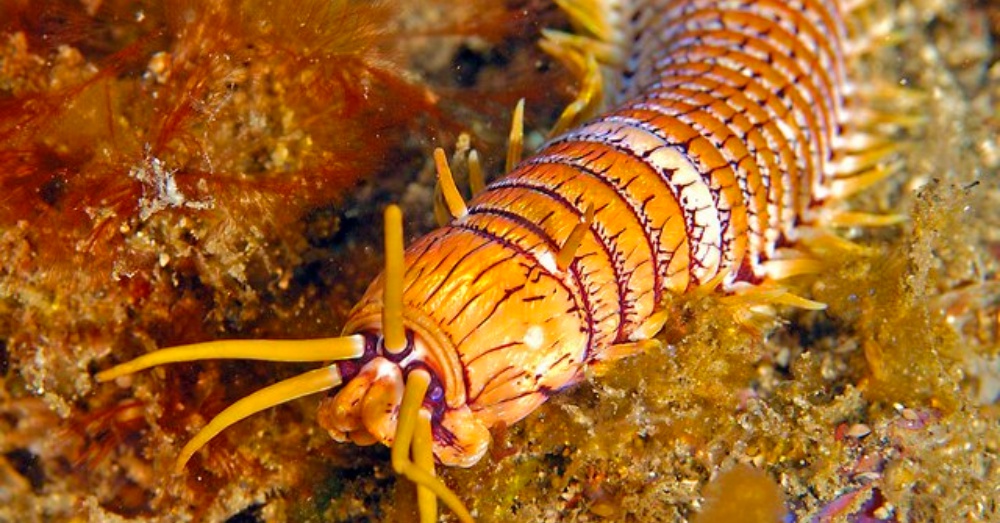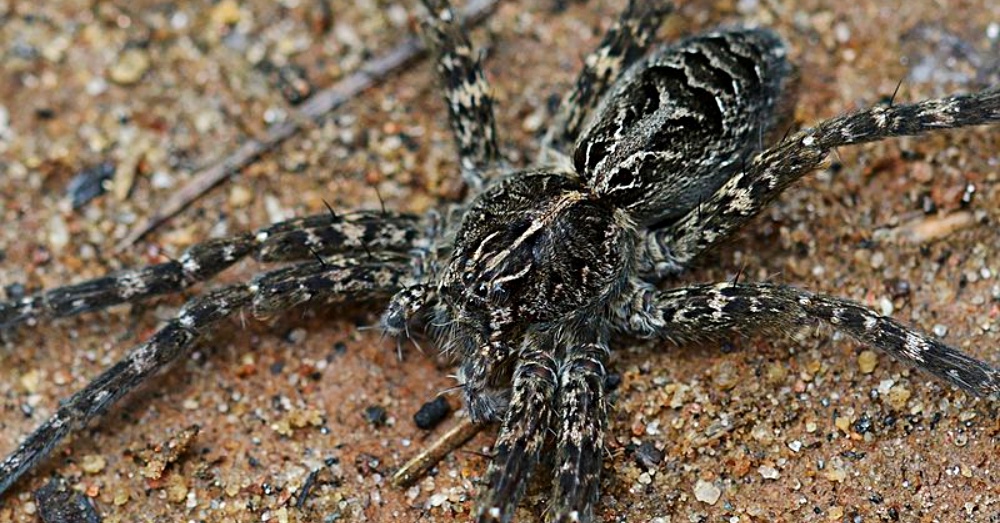
12 Creepy Crawly Animals That Just Might Give You Nightmares
It goes without saying that here at The Rainforest Site we love animals. Of course, like everyone else, we love majestic big cats, thoughtful elephants, and powerful (yet adorable) bears! We think sharks are just as exciting as the next person, and don’t get us started on whales.
But those animals get all the attention.
We love the animals that live on the periphery, as well. The ones that aren’t quite as glamorous as lions, and tigers, and bears, but are just as cool (and essential to the ecosystems in which they live). To that end, we want to take a moment to honor the ones that are creepy, crawly, and just a little weird. Enjoy!
12. The Bobbit Worm, AKA: The Sand Striker
The Bobbit worm may look small upon first glance, but don’t let what’s above the surface of the ocean floor fool you. They can grow to be up to 10 feet long! These sly predators dig themselves into the ocean floor, leaving only a few inches of their bodies exposed above ground for hunting.

Using five-hooked antennae, the bobbit worm senses its prey, and when the time is right, it strikes. Using a part of its mouth called the pharynx, the worm chomps down on its victim—its speed and strength powerful enough to split a fish in half!
11. The Hagfish
By traditional beauty standards, hagfish aren’t exactly attractive animals. They’ve got eel-like bodies, sensory tentacles that protrude from their mouths, and they’re super slimy. And while you might be inclined to say, “Oh, but they have great personalities,” you might be a little off. They use the aforementioned sensory tentacles to find food–typically the carcasses of larger animals.

They use their sharp teeth to bite off chunks of meat, as well as to burrow into the carcass of their meal. As they make their way in, they’ve been known to eat so much that their bodies become too engorged to make their way out the way they came in.
But that’s no problem for the hagfish. They simply take up residence in the rotting carcass until their food is digested.
While hagfish may not be as cute and cuddly as say, panda bears, we still think they’re pretty cool!
10. The Horse Conch
The horse conch can be found in the shallow ocean waters from the Atlantic Ocean to the Gulf of Mexico. With the ability to grow to be up to two feet long, these massive sea snails are the largest saltwater snail in North America and the second largest in the world!

And it’s not just their immense size that makes them intimidating. The horse conch is also a predator, feeding primarily on clams, mussels, and other snails.
9. The Powelliphanta Snail
If you think there’s no way two snails could make a list about creepy, crawly animals, then clearly you’ve never heard of the Powelliphanta snail. These guys are carnivorous and large. Think: the size of a fist.

See that picture above? That’s an image taken from a video wherein an unsuspecting earthworm gets devoured like a flimsy noodle by a hungry Powelliphanta snail. Kinda gross, but totally cool!
8. The Tuatara
The tuatara is not your average lizard. Sure, it definitely looks like one, but these reptiles are old–really, really old. They’re actually the last survivors of an order of reptiles called Sphenodontia, which has been around for 200 million years. Meaning: they walked the earth with dinosaurs and outlived them.

Tuatara are native to New Zealand and are the region’s largest reptile, measuring between 12 and 30 inches and weighing up to three pounds.
The spines that run from their necks down their back lend themselves to their name–”tuatara” comes from the Maori language and means “peaks on the back.” In addition to making them look super cool, the spines also serve as a sort of courtship display for males who can fan them out to attract a potential mate.
7. Troglobites
So, these critters aren’t necessarily frightening, but they certainly live in a place that’s not very welcoming–incredibly dark caves. Troglobites have evolved in some truly incredible ways so they can thrive in the dark!

While many troglobites are blind (sight isn’t all that important if you live in constant darkness), they more than make up for their lack of sight with their other senses. Some have a highly-developed sense of touch, while others have an excellent sense of smell or hearing.
6. The Fishing Spider
The fishing spider (or raft spider) is large, brown, and pretty scary looking–even if you’re not an arachnophobe. Their spindly legs might be creepy, but they allow them to walk on water, and tiny spikes on those legs allow them to detect activity in the depths below.

Not impressed?
Not only can it tell where the movement is coming from, they’re able to sense what type of animal is creating it.
Why would they need to know what’s happening below the surface? Oh, because they feed on fish and aquatic invertebrates! What’s cooler than a spider that knows how to fish!?
5. The Komodo Dragon
The Komodo dragon barely makes our list–after all, are there many people who wouldn’t agree there isn’t a certain beauty in their strength? However, since they engage in some stalker-like behavior, we’re going to go ahead and include them.
Komodos hulking size to smash potential prey to the ground. If that doesn’t sound all that impressive, try imagining a lizard taking a deer’s legs out, knocking it to the ground, then using its powerful muscles and claws to tear through its flesh.

Their teeth are serrated and curved, allowing the Komodo to rip meat apart with minimal effort. With smaller prey, the lizards are inclined to go straight for the animal’s throat, rendering it immediately incapacitated.
If, on some outside chance, their meal was to escape, the animal’s luck would run out quickly. Once bitten by the Komodo, their deadly venom begins to work its magic, leaving the infected animal with little to no hope of survival. All the Komodo has to do at that point is wait.
4. The Angler Fish
When it comes to animals that live in the harsh conditions of the deep sea, the angler fish is one of the more commonly discussed, but its weirdness never ceases to amaze me. While beauty is generally in the eye of the beholder, I think you’d be hard pressed to find anyone who thought this grumpy looking fish wasn’t one of the lease attractive animals on the planet.

One of their most distinctive features is a dorsal spine that protrudes from its head. While super weird looking, this rod-like extension helps them catch their prey by luring them close enough to snatch up!
And if that’s not impressive, chew on this: their mouths are so large and malleable anglerfish are capable of swallowing a meal twice their own size!
3. The Stonefish
The stonefish isn’t very attractive. But what it lacks in looks, it more than makes up for in speed. And that’s not the only thing that gives it an edge as a predator. It’s also a master of disguise, and are known for their keen ability to blend in perfectly with their surroundings, and are known to patiently near the ocean floor for an unsuspecting victim to cross their path.

And while that is all very impressive, it’s possible that I’ve buried the lead. These speedy camouflage experts have another trick in their repertoire, and its located snuggly within their skulls.
Scientists call the feature a “lachrymal saber,” but we’re calling them switchblades. And they can be rotated 90 degrees to act as a weapon when needed. Oh, and did I mention they’re embedded with sharp spines that secrete venom that, in some species, can kill a human? Yeah, they made the list due to pure intimidation.
2. The Cone Snail
That’s right. A third snail. But hear us out. These snails certainly are lovely, but they’re as deadly as they are beautiful. A single drop of this snail’s venom is powerful enough to kill 20 adult humans! While some animal’s venom may be deadlier, none cane do so much damage with so little.

A cone snail sting can result in tingling, swelling, numbness, and intense pain. In extreme cases symptoms include respiratory paralysis, vision impairment, and muscle paralysis. The fact that you may experience the effects immediately, but they could take days to appear does little to put my mind at ease!
1. The Goliath Bird-Eating Tarantula
The goliath bird-eating tarantula is enough to make even the most devoted arachnophile’s skin crawl.
For starters, it’s the largest tarantula on the planet. So, for some, it’s the creepiest of the creepy. Or, maybe its ridiculous size provides you with a degree of comfort–after all, it would be pretty difficult for a spider with an 11 inch leg span to hide in your shoe!

Of this spider’s eight legs, four of them are covered in spines. Which, you know, can make it look a little menacing… or maybe just adorably fuzzy. It all depends upon your perspective.
The goliath bird-eating tarantula’s fangs, however, are a little harder to put a cuddly spin on. In addition to its fangs, which, incidentally, fold under its torso and determine the directionality of their attacks–they typically impale their prey from above, they also have four fang-like appendages near their mouth–two of which contain venom!